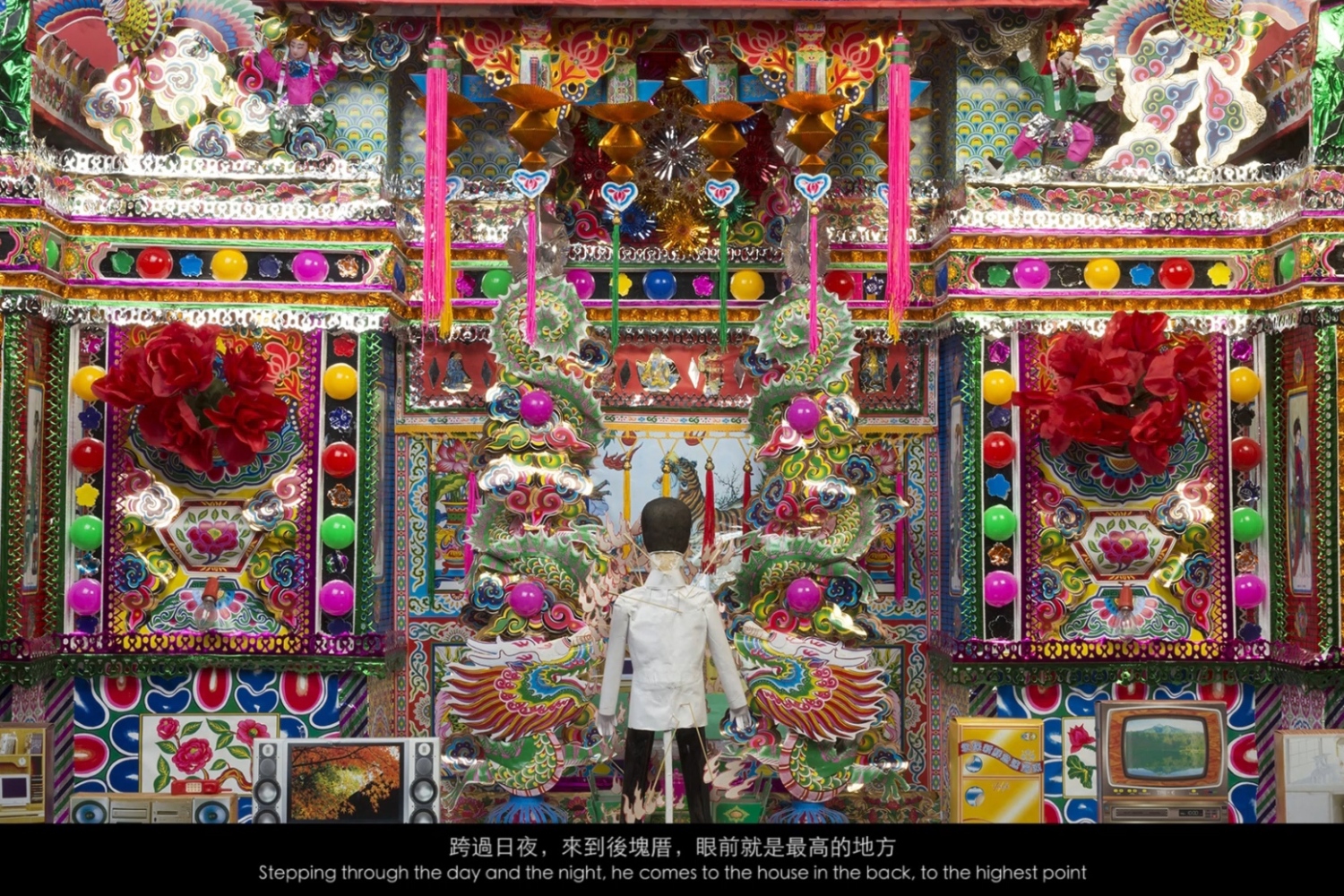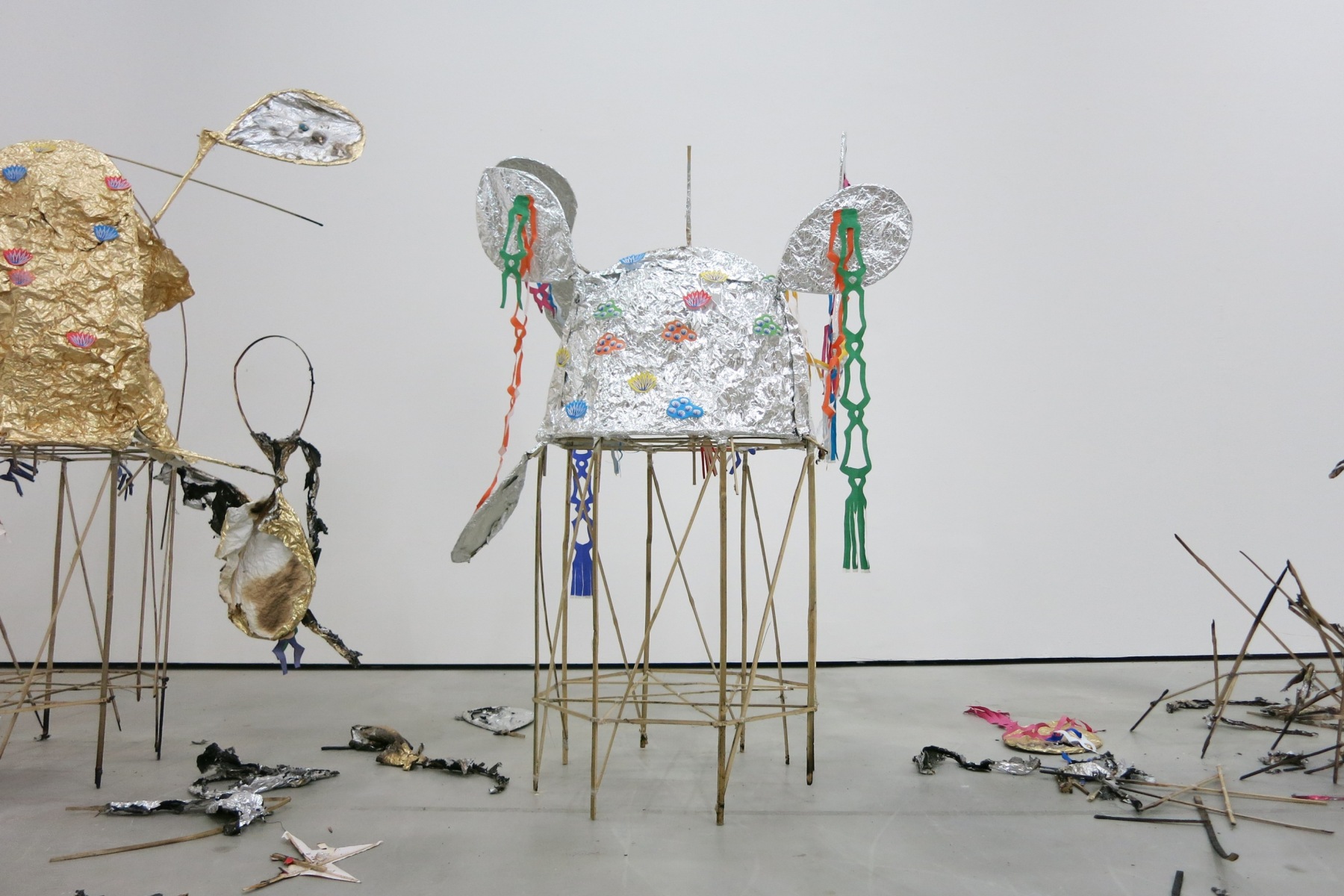「花山牆」用既有的藝術手法(雕塑、相片、影片)與傳統紙紮文化進行形式與象徵上的揉合,相互補充。新作「花山牆」的主要概梗為描述一名自焚而亡的男子,也就是「魂身」來到陰間,按照傳統習俗,來到了紙紮屋厝並登高位以俯視所有財富的過程。從這過程當中魂身穿越了歷經明清、荷西、日據、國民黨以及跨國資本殖民的鑿痕。
花山牆是藉由錄像、裝置與民間紙紮工藝,在陰陽兩界的對照之下,揭示了台灣被殖民的歷史、政治與文化現況全新的觀照面相,並為台灣當代藝術敞開一個與全球藝術對話的窗口。
Hua-Shan-Qiang applies existing mediums (sculpture, photograph, video) to the traditional culture of paper offerings to create a combination of form and symbolism in which the two serve to complement one another. The new work Hua-Shan-Qiang centers around the story of a man who died in the act of self-immolation, who enters the underworld as a spirit. In accordance with traditional custom, he arrives at a house made of a paper offering and ascends to overlook all of his fortunes. In the process, his spirit passes through the vestiges of the Ming Dynasty, the Qing Dynasty, the Dutch occupation, the Spanish occupation, the Japanese occupation, Kuomintang, and capitalist colonialism.
By comparing the realms of the living and the dead, Hua-Shan-Qiang offers a new perspective on the history, politics, and culture of Taiwan's colonial history through video, installation art, and folk paper craft, opening up the window for global artistic dialogue for Taiwanese contemporary art.
蘇育賢 SU Yu-Hsien
1982年出生於台南,曾就讀台南藝術大學造形藝術研究所,2007年獲得世安美學獎、高雄獎、台北美術獎首獎,2008年於光州美術館個展。策劃展覽包括關渡美術館「COQ-Young Taiwanese Artists from Nobody Collection」。2011年獲選參加「第54屆威尼斯雙年展:聽見,以及那些未被聽見的-台灣社會聲音圖景」。
Born in 1982 in Tainan and was educated at the Graduate Institute of Plastic Arts at Tainan National University of the Arts. In 2007, he was awarded the S-An Arts Award, the Kaohsiung Award, and the Taipei Arts Award's first prize. In 2008, his works were featured in a solo exhibition at the Gwangju Museum of Art in South Korea. He has curated exhibitions including COQ-Young Taiwanese Artists from Nobody Collection. His works were presented as part of The Heard and the Unheard: Soundscape Taiwan at the Taiwan Pavillion at the 54th Venice Biennale in 2011.
蘇育賢
李旭彬、陳伯義、林柏樑
林睿洋、吳宗龍、黃彥穎、江忠倫
林亮宇、林睿洋
王寶星
太乙紙藝
耿畫廊 Tina Keng Gallery
關鍵字
- 裝置
- 攝影
- 影像
- 紙札
- 傳統技藝
- 歷史
- 隱喻
- 鄭南榕
- 喪禮
- 儀式
- 錄像
藝術家談作品
紙紮不再是一個宗教性的問題,這牽扯到作為人的慾望,這個慾望也包含你希望你個人與這個社會的互動延續性。
紙紮不再是一個宗教性的問題,這牽扯到作為人的慾望,這個慾望也包含你希望你個人與這個社會的互動延續性。
評審談作品
從人的生死過渡到國家生死的醒世喻言。
入圍理由 Reason for Nomination
「花山牆」闡述的是台灣民間議題,借由藝術專業介入,將議題精緻化、當代化、都會化,也將禁忌議題檯面化,如此的作為,使觀者足以放鬆的審視生命週期非常有限「紙厝』,藝術家的專業提點,使「花山牆」成為極為entertaining 的作品,觀賞藝術,分享藝術家獨特觀點,也得到愉悅感受,真是太好了。提名觀察人 ─ 李俊賢
“Hua-shan-qiang” discourses social issues of Taiwan; through professional intervention of art, the issues are made intricate, contemporary, and urbanized; taboos are also laid on the table. This action allows viewers to relax and admire the “paper house”, which has a very limited life cycle. Artist’s professional maneuver turns “Hua-shang-qian” into an extremely entertaining work. Admire artworks, share the artist’s viewpoints, and be entertained. What a pleasant experience! Nominators: LI Jiun-Shyan
年度入選獎得獎理由 Reasons for being Shortlisted
在跨界的媒介與跨域的人文思考,蘇育賢游移於真實世界與想像人物之間的精湛手法,將逐漸庸俗化的台灣民間祭儀和喪禮轉化為藝術語言的創新,並與古雅台語共構成一場冥界之旅。花山牆是藉由錄像、裝置與民間紙紮工藝,在陰陽兩界的對照之下,揭示了台灣被殖民的歷史、政治與文化現況全新的觀照面相,並為台灣當代藝術敞開一個與全球藝術對話的窗口。複選委員 ─ 陳泰松、林于竝、邱坤良、阮慶岳、林曼麗、陳昌仁、陳郁秀、石瑞仁、吳靜吉
Su’s masterful skills interweave real-world and imaginary characters, turning the increasingly vulgar ceremonies for funerals in Taiwan into an innovation of artistic language through interdisciplinary media and cultural thinking, which co-construct a journey to the underworld with classical Taiwanese language. By comparing the realms of the living and the dead, Hua-Shan-Qiang gives a new perspective of the history, politics and culture of the colonized Taiwan with videos, installations, and folk paper crafts, and opens up a window of dialogue with global arts for Taiwan’s contemporary art. Semi-selection jury: CHEN Tai-Song, LIN Yu-Pin, CHIU Kun-Liang, ROAN Ching-Yueh, CHEN Chan-Jen, CHEN Yu-Hsiu, SHIH Jui-jen, LIN Man-Li, WU Jing-Jyi
年度大獎得獎理由 Jury's comments
集結喪禮儀式、建築樣式、紙紮工藝與戲劇文本,以說故事的方式,悠遊於紀錄、表演與電影類型的跨越。「靈厝」體現了現實世界缺落的慾望所砌出來的烏托邦。在視覺藝術的文脈當中,開啟了劇場性的另類思考。敘事者時而詼諧、時而抒情的聲音,控制這齣「死亡大戲」的情感調性,不帶心理分析的簡潔敘述,有效地讓故事留在人們的記憶中。藝術家細膩隱喻了台灣被殖民的斷裂歷史,以及對當前國家前途未卜的感受。這個作品是從人的生死過渡到國家生死的醒世喻言。決審團 ─ 邱坤良、陳泰松、林于竝、相馬千秋、葛拉姿亞 ‧ 格隆尼
By combining Taiwanese funeral ceremony, architectural form, the “house” for the spirit of the deceased made by paper craftsmanship, and theatrical text, the work elegantly crosses the boundaries between documentary, performing art, and movie genres in the way of storytelling. The “house” embodies the unfulfilled desires in this life. The artist opens the door to new possibilities for alternative thinking for theatricality within the context of visual art. The narrator is sometimes humorous, sometimes sentimental; his voice controls the emotion presented in this “Drama of Death”. The modest narration without providing psychological analysis effectively imprints the story in the memory of the audience. The artist delicately implicated the disrupted colonized history of Taiwan and the uncertainty about the nation’s future. It is an awakening metaphor about the passage from the life and death of human beings to the life and death of a nation. Final selection committee member: CHIU Kun-Liang, CHEN Tai-Song, LIN Yu-Pin, Chiaki Soma, Grazia Quaroni






